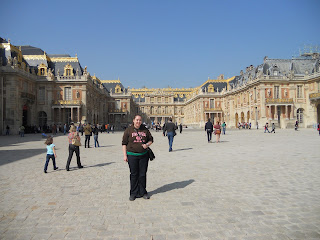Junior Archaeology major Emma D. is at Harlaxton this semester, and this is a report on her travels in France.
The first night in Paris, some friends and I decided to get some bread and wine since it seemed fitting. We had wanted to walk down by the river but we couldn’t find the river at first; as we were walking behind this building, Luke said, “This building looks important; let’s find it on the map." The building we were standing behind was the Louvre! As we were about to cross the street, we all stopped and looked up, and what did I see but the Eiffel Tower in all its glory, with thousands of sparkling lights and a spot light on the top. Well, it took two hours to actually make it to the base of the Eiffel Tower, but it was amazing. I’m so glad we went to see it that first night, as it made us feel that we were really in Paris!
The next day we went to Notre Dame, where I took a picture of every stained glass window. The entire time I was there I was singing "God Bless the Outcasts" from the Hunchback of Notre Dame. After that, we walked across the River Seine, saw scuba divers, and made our way to the Louvre. We had been walking around the Louvre for about three hours when, suddenly we walked down some stairs and there was this large stone wall in front of us: a moat wall. I couldn’t believe that the Louvre has a moat! The History Museum in Houston has nothing on the Louvre.
The next day, Sarah and I went to the Chateatu de Versailles and it was amazing! Every room was better than the last and it was all simply gorgeous. I could have spent years there; I took a photo of every room. We walked around the gardens for a couple of hours and, although nothing was blooming yet, it was still magnificent. After the gardens we walked to the Grand Trianon, which is made of pink marble. After that, we saw the Petit Trianon, which had been made for Marie Antoinette. There was even a Love Temple.

The next day we walked to the Sacred Heart Cathedral and down the Champs Elysees towards the Arc de Triomphe, which was amazing! It was fascinating to imagine all the famous people who had walked or driven down the Champs Elysees. I walked in the footsteps of Roosevelt, Eisenhower, Churchill, de Gaulle, and even Hitler. After that we went back to the Eiffel Tower and started the climb up, except when we reached the second level we had to buy tickets to reach the top and there was a two- hour wait, and the ticket booth would not be open for another two hours. So we decided to wait until it started to rain, and then we made a hasty exit. But we still got drenched …
All in all, my trip was amazing and I love Paris!





